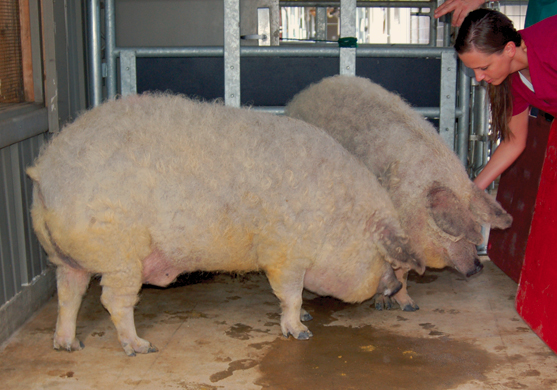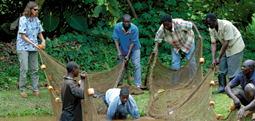| Current Issue | Past Issues | Subscribe | Ag Homepage |

Models for Health
A curly-haired, morbidly obese, genetically primitive breed of Hungarian pig that until recently was on the brink of extinction could be key to the eventual prevention of diabetes and heart disease in humans, Auburn University researchers contend.
The breed is the Mangalitsa, and two years after importing the initial group of piglets from their native land to the Auburn University Swine Research and Education Center, Auburn animal scientist Terry Brandebourg has determined that as the commonly called “wooly” pigs pack on layers of adipose tissue, they spontaneously develop symptoms of metabolic syndrome similar to those that obese humans develop, including insulin resistance, liver dysfunction and inflamed adipose tissue.
That discovery could become as huge as the Mangalitsa is fat, leading to the development of therapies that will not only treat but prevent diabetes and associated health conditions.
“We know that obesity is linked to diabetes and diabetic heart disease, but we haven’t fully understood the mechanisms underlying those links because there hasn’t been a suitable translational animal model that allows us to observe how increasing adiposity induces these health conditions,” Brandebourg says. “But our initial experiments using the Mangalitsa indicate that as they amass body fat, their systems mimic obesity-related metabolic problems that we see in people.”
With their data thus far supporting the genetically corpulent Mangalitsa’s potential as the much-needed novel model, Brandebourg and research collaborator Rajesh Amin in the Harrison School of Pharmacy have begun using the magnetic resonance imaging scanner at Auburn’s MRI Research Center to image the wooly pigs’ cardiac functions, in an effort to study how obesity affects heart health.
Funded by an Alabama Agricultural Experiment Station grant they were awarded last fall, the scientists also are supplementing the animals’ diets with conjugated linoleic acids, or CLAs, a group of naturally occurring fatty acids that has exhibited anti-inflammatory, anti-atherosclerotic and anti-diabetic effects in studies with mice.
“We’re looking at the potential of CLAs to uncouple metabolic and heart dysfunctions from obesity,” Brandebourg says. “What if reducing the risk for diabetic heart disease turns out to be as simple as taking CLA supplements?”
Brandebourg says Brian Anderson, who manages the Swine Research and Education Center and is responsible for the day-to-day care of the animals there, is a key player in the wooly-pigs project, as are several graduate and undergraduate students who are actively involved in the study. One of the undergrad researchers, Auburn senior Christine Garrett, presented the data establishing the Mangalitsa as a metabolic model for diabetes during the fifth annual Boshell Diabetes Research Conference, held earlier this year in Auburn.
The use of swine as animal research models for certain human medical conditions is widely accepted because, as a species, pigs are both physiologically and metabolically similar to humans. But in lab trials, scientists have not yet identified a domestic breed that faithfully models the natural progression of diabetes as carcass fat increases without additional experimental intervention. That’s what inspired Brandebourg to search for the most obese, rudimentary breed on the planet, and that led him to the Mangalitsa.
In Hungary, the breed is called Mangalica, which means “hog with lots of lard,” and that is quite an understatement. The carcass of a mature Mangalitsa is 70 percent fat, and the fatback is three times thicker than that found on today’s leaner breeds, such as the muscular, industry-standard Yorkshire pig.
Mangalitsa pigs, descendants of wild boars and lard pigs, emerged in Eastern Europe in the mid-19th century and were prized for their light and clean-tasting lard and succulent texture and flavor, but demand for Mangalitsa products waned after World War II, given the advent of lard alternatives and the trend toward fast-growing, lean pork.
What goes around comes around, however, and today, chefs at five-star restaurants on the East and West coasts increasingly are discovering that meat harvested from the Mangalitsa is more highly marbled, is of superior color and is significantly tenderer than that from Yorkshire hogs and are paying premium prices for dry-cured Mangalitsa meat.
Thus, while still primarily focused on the Mangalitsa’s promise as a translational animal research model for human diseases, Brandebourg also is collaborating with fellow Auburn meat scientist Christy Bratcher to investigate the breed’s potential as a quality food animal. Their initial data indicate that Mangalitsa meat is considerably higher in monounsaturated, or “good,” fatty acids and lower in undesirable saturated fats than pork from Yorkshire hogs, factors that suggest Mangalitsa meat is healthier to consume, Brandebourg says.







